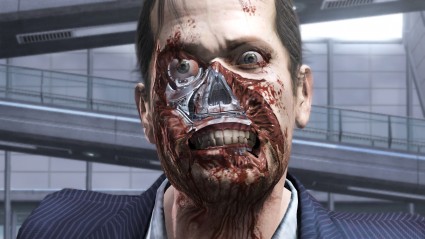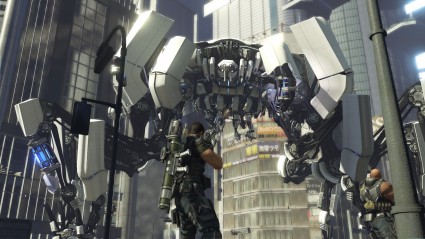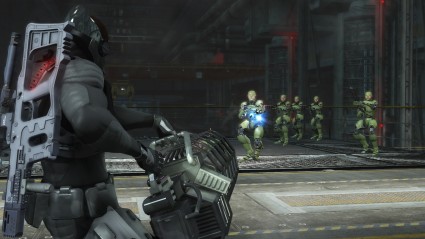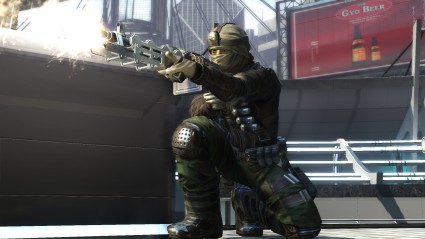Reviews
Binary Domain
March 27, 2012, Author: Andy Corrigan
Binary Domain has been a bit of a weird one. I’d heard bugger all about it until a few weeks before it was released, and Sega haven’t exactly been backing it with the big marketing bucks. Neither of those scenarios are a good sign, let alone both, and my thoughts harked back to the shoddy mess that was Alpha Protocol.
Thanks to a postal error, my review copy turned up a few weeks late. Up to my eyeballs in Vita reviews and not feeling too optimistic about the game’s chances at that point, I can’t admit to being too deeply disappointed with the delay. Now? I’m still glad that it arrived late, but not for the reasons I had originally thought…
It’s a game that’s been largely ignored by the buying public and having now played it, I think it deserves a second look. This delayed review might just get people to give it that much.
11001100011100011110
If you look beyond the generic, badly drawn box art, which indicates nothing more than a setting of macho space marines with little context, you’ll be a fair way off the crux of what this game is about.
It’s the year 2080, and the robotics industry has come a long way since our time today, with two rival companies vying for control of the market. Their rivalry hits amazing new heights, as a man attacks the Bergen building in the USA aiming to kill the company president. In the confusion, it’s revealed that the attacker was actually a robot; one who had been living a normal human life and had, up until now, been blissfully unaware what he was. He was dubbed a ‘Hollow Child’, and he was just the tip of the iceberg.
With the scenario of robots passing for humans breaching international law, the US Government suspect that Bergen’s closest rivals, the Japanese Amada Corporation, are to blame. They dispatch a Rust Crew to Japan; a unit specialising in investigating breaches of the new Geneva Convention. Their mission is to capture Yoji Amada alive and question him.
What none of this tells you is just how much character the game has, with a type of gung-ho approach that we haven’t seen in shooters since the last generation. It’s in that mildly hammy way that only the Japanese can get away with, but after the bleak doom and gloom of nearly every shooter to hit the Xbox 360 or PS3 in recent years, it’s so refreshing to experience an action game that takes itself slightly less seriously. Never to the point of absolute ridiculousness, though, let me reassure you. Along with many twists and turns, Binary Domain does have its deep moments too, and poses a serious ethical question come the end; however, to delve deeper here will spoil the game somewhat.
A massive part of what the game does well comes in the form of the cast you’ll meet along the way. You play as Dan Marshall, a typically cocky but likeable soldier, but he is quickly outshone by his multi-national supporting cast. Charlie, Fei; hell, all of them mesh well with Dan’s fiery personality with fun dialogue in both cut-scenes and gameplay. My favourite character by far was the French operative Cain; a robot who was both unstereotypically badass, but intentionally comical throughout.

The Hollow Children are coming for you!
Should you vocalise your support for the troops?
On the face of it, Binary Domain plays just like any other squad-based cover shooter, but it does bring its own ideas to the table. As you’d expect, for the most part you’ll be running from cover to cover with (typically) two colleagues at your side, popping up and shooting enemy robots until they have the decency to die. Gameplay flows nicely here with solid combat, while all guns provide a nice feedback, feeling powerful and robust.
The enemies are great fun to fight and come in many varieties, including grunts, speedy close-quarter fighters, tank classes with mini-guns and many more. They all fight aggressively, and are enjoyably tough to take down. As you tear into them, they come apart satisfyingly as you strip them of their protective armour, and you can target specific body parts for great effect.
Taking out their legs, for example, means they’ll crawl towards you with all the tenacity and mannerisms of the T-1000. If you can decapitate one, they’ll lose track of who to attack, causing conflict within their own ranks; it’s so nicely done. Boss fights are huge spectacles, involving epic, drawn out battles that evolve as you fight. These really are a joy to experience.
As is the way with most titles these days, there are some RPG aspects to toy around with and, with a Japanese company at the helm, it’s fitting that the menus are presented almost akin to a JRPG, albeit a lot lighter in implementation. You need to micro-manage your squad, regularly choosing which colleagues should accompany you for particular sections and upgrade them how you see fit; and the main way for that is upgrading their specialist weapon. For every robot body part you destroy, you earn credits that can be spent at shop stations littered regularly around levels. Here you can buy those upgrades, while also purchasing new weapons, ammo and Nanobyte upgrades.
Using the Nanobytes, you can change the abilities of your team, giving them different perks. While you will buy most of these at the service stations, you will find many littered around. You can’t just add them as you want, though, as you’re given a small 2×3 grid, and the nanobytes take up different shapes. So for example, increased health might take up three slots in an L shape, meaning that you’ll need to position it properly in the grid if you want to add in some more abilities, such as tougher defences or faster health regen.

Yup, you get to fight this thing...
The unique advertised feature, of course, is voice control, and funnily enough it can be any mic, not just Kinect. The main function here is to utilise tactics, asking your teammates to charge, hold or fire on your target. The kindest thing I can say about this is that it worked for me, but never brilliantly; possibly my Yorkshire accent playing a part in that at times. Thankfully, for those of us that don’t want to yell at our tellies in to issue orders or respond to buddies, you simply have to hold down the left bumper and select the appropriate face button. It’s a clean and simple alternative.
Voice controls are also used as part of the trust system. At moments throughout, your party will talk with Dan, often about each other or his thoughts on certain political subjects. Your responses will have an effect how well your squad-mates will obey you in the midst of combat.
To be honest, it’s a fresh idea but ultimately it felt a bit pointless. You will simply always choose the answer they want to hear or they become less useful to you. This takes away the feeling of directing Dan as you want, making him seem like an agreeable doormat. You never really bond well enough with anyone to see it make an impact on your decision-making either.
Truth be told, the trust system works slightly better in general gameplay anyway; you lose influence if you tag teammates accidentally with friendly fire or don’t help them when they’re downed. If you do badly in a big firefight, they’ll quickly let you know about it in a quieter period later on down the line. Even then, the friendly A.I. will occasionally let you down, as they aimlessly meander into your line of fire and then complain when they get hit as a result.
What I did take away from Binary Domain more than anything, is that all the cool, action-packed stuff that you see in other games that’s usually reserved for cut-scenes and hands-off events, Binary Domain lets you do yourself. It took me by surprise a couple of times with this, as I plonked the pad down, ready to watch the story unfold, before it threw me back in control unceremoniously and let me navigate through all the awesome (although clichéd) action movie moments.
Think about shooting robots off a colleague as they dangle precariously from a lift, or sliding across the floor in slow-motion to kick a gun in the air before catching it and planting a bullet between someone’s eyes. Binary Domain lets you play at least a small part in nearly all this, and it’s a little richer as a result.

The shrapnel is about to start flying!
Ooooh shiny…
It’s a strange thing. The first time I booted up Binary Domain, I couldn’t decide whether it looked great or bland. Dan and his teammates were extremely well designed (except for Rachael, who looks like a cross between Arnold Schwarzenegger and Skeletor), with parts of their armour shimmering nicely in the night rain. It looked immensely cool, but there was just something I couldn’t quite put my finger on. The further I played, I realised; it simply had a cleaner look than I was used to for most cover-shooters.
This is a game about a future obsessed with robots and technology after all, and it shows with clean plastics and metal combining for an almost clinical feel, even in the more war-torn areas. Like the environments in Portal, or even Mirror’s Edge, if you look a little deeper, you’ll see the cracks starting to show. Even with that, it still manages to vary the types of location you’ll visit throughout, and often has great visual impact each time you see a switch in style.
My favourite aspect visually, though, was simply in fighting the enemies. While not quite as menacing as anything in say, The Terminator, they come apart fiercely and believably as you shoot them and expose their skeletal frames. Not only does it look brilliant, but it reinforces the feeling of the damage you’re dishing out. The boss fights take this to an entirely new level, with each intimidating, towering beast providing a huge sense of scale as they try to put you on your arse.
Sound off!
While the combat certainly looks good, it sounds wonderful too, thanks to Sega’s excellent use of audio. This is particularly true of the weaponry, with each gun sounding beefy, while there’s a great sense of impact when you’re dead on target. Unfortunately, the combat experience is marred slightly by the repetitive chatter of your colleagues, who blurt out the same quips over and over (and over and over… gah!).
That aspect is a shame, because otherwise, despite the script and dialogue remaining a little more light-hearted than your standard Western cover-shooter, I think the voice actors did a great job overall. While not exactly Uncharted, there’s decent characterisation here, and a lot of that stems from those behind the microphone.
The soundtrack… well… the fact I’ve not mentioned it yet probably tells you that it isn’t especially remarkable, but it does its job effectively enough. If you think big, dumb action movie, you’re probably in the right ballpark.

This screenshot is pretty much the closest I got to the multiplayer mode...
The domain is dead…
Binary Domain hints at a meaty online mode, with its own takes on typical Death Matches, Last Man Standing, Attack/Defend, Capture the flag, Demolition and Domination game types. There is also an Invasion mode, which is essentially Horde mode, played over just three maps.
Unfortunately, I was unable to sample any of these delights as the community is already dead. I tried for a few hours, searching for all game types and only found one solitary Domination match with just a handful of people therein. Not only that; it was riddled with horrendous lag, making any enjoyment impossible.
That’s all I was able to determine I’m afraid. The online mode exists, but it’s already dead and also possibly broken.
Not a hollow experience
If you ignore the broken multiplayer, the mostly pointless trust system and the hit-and-miss nature of the voice commands, you’re still left with an incredibly solid, charismatic and enjoyable cover shooter. Binary Domain has got a lot more going for it than most other Gears of War clones, managing to tell a surprisingly intricate and entertaining story in spite of all the big dumb fun.
Whether or not you have room in your life for another cover shooter is your own call to make, of course, but this is a game with real character and it at least deserves a chance. Give it a go. Like me, you might be pleasantly surprised.
Platforms: PC, PS3, Xbox 360 | Tagged binary domain, cover shooter, dystopian, Futuristic, Gears Of War, multiformat, Multiplayer, Robots, Sega, Shooter, Terminator, Third Person Shooter



